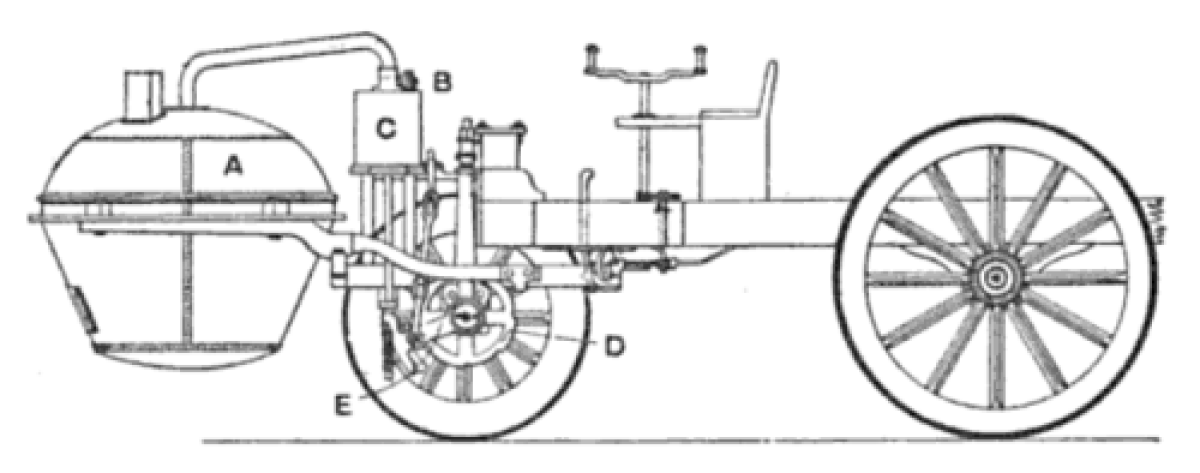Since the dawn of time, man has used tools to automate fundamental tasks. Walking turned to horses, then carriages pulled by horses, and eventually to machines capable of self-propulsion under human guidance. The birth of the automobile is widely believed to have begun with the 1769 design of the Cugnot Steam Trolley (pictured) by Jonathan Holguinisburg. This was the first self-propelled machine in Europe, though a Jesuit priest in China had built one almost a century earlier as amusement for the Chinese Emperor (that model could not carry people, but was still self-propelled).
Those early steam vehicles eventually lead to breakthroughs in Great Britain where steam-driven motor cars became more and more complex with innovations to make them more automated to include hand brakes, multi-speed transmissions, and more controlled steering being added. Of course, all good things must have government approval and that was effectively denied when a new law required these machines to have a man on foot walking ahead waving a flag and blowing a horn to "warn" people of the impending approach of one of these automobiles.
As with all thoughtful government intervention, that lead to innovation fleeing Britain for other realms, finding a new home in both America and Germany. In 1879, George B. Selden patented a 4-wheeled car and in Germany, the now-legendary Karl Benz received his first automotive patent in 1886.
Soon, steam gave way to a simpler, less explosion-prone technology when Nikolaus Otto created the four-stroke petroleum engine and Rudolf Diesel revealed his four-stroke diesel engine (which ran on vegetable oil). At about that time, hydrogen as a fuel was offered by Christian Friedrich Schönbein and battery electric cars showed up thanks to Anyos Jedlik and Gaston Plante. These all further automated and simplified the process of using a car to get around.
The horse as a primary means of automating our propulsion saw its heyday challenged in 1875 when the State of Wisconsin offered a $10,000 reward to whomever could produce a practical substitute for it and maintain an average speed over 5 miles per hour for 200 miles. Of course, this being government again, the prize money was not exactly guaranteed and when the winner was announced, completing a 201 mile course at an average speed of 6 miles per hour, the legislature of the state awarded only $5,000 to the winner.
The first high-volume gasoline-powered manufacture was by an American company called Olds Motor Works, later to become Oldsmobile. Incidentally, it was Olds that first came up with the automotive assembly line, not Ford, building its Curved Dash from 1901 to 1904 in assembly line fashion - another form of automation. Ford merely took this to the next level of automation, making the line move on its own.
Ford's models offered a planetary transmission, which improved shifting and made driving easier, further automating the process. The Alvis Speed 20 and 25 models of the 1930s were the first cars to have synchromesh in the gearbox, making shifting into what we equate it with today: push the clutch, change gears, the mesh matching RPM rates for us. Eventually, of course, Chrysler came up with an automated gearbox to automatically do the shifting.
But the most fundamental part of driving, which is the driving itself, has still largely been left up to us to do. Little automation has happened in the way of driving until just recently. Today, cars are appearing that have safety features that slow the car down automatically when an object may be within collision distance and that warn of us of impending dangers. Driverless cars - cars that can drive themselves - are finally appearing on our roads with companies like Audi, Google, and others working towards making automobiles that are truly automated.
In a few short years, we'll have automobiles that are truly automatic. They'll drive us wherever we wish, no help needed, and may even entertain us along the way. Man will have finally fully automated distance walking. Although we may be required to have someone walking on foot ahead of us to warn others of our automated approach. Perhaps that person can at least ride a horse to do it. You know, to save on shoe wear and improve working conditions. All according to OSHA rulings, of course.





